A Review of Cavitation Erosion on Pumps and Valves in Nuclear Power Plants
Abstract
:1. Introduction
2. Cavitation Erosion Test Methods
3. Cavitation Erosion on Valves and Pumps
3.1. Cavitation Erosion on Valves
3.2. Cavitation Erosion Mechanism of Valve Materials
3.3. Cavitation Erosion of Valve Sealing
3.4. Erosion-Corrosion of Valve Sealing
3.5. Cavitation Erosion of Promising Valve Sealing Materials
3.6. Cavitation and Cavitation Erosion on Pumps
3.7. Cavitation Erosion Mechanism of Pump Materials
3.8. Cavitation Erosion of Pump Materials with Coatings
4. Conclusions
5. Future Directions
Author Contributions
Funding
Institutional Review Board Statement
Informed Consent Statement
Data Availability Statement
Conflicts of Interest
References
- Ingersoll, D.; Houghton, Z.J.; Bromm, R.; Desportes, C. NuScale Small Modular Reactor for Co-Generation of Electricity and Water. Desalination 2014, 340, 84–93. [Google Scholar] [CrossRef]
- Ahmed, W. Nuclear Power—Practical Aspects; IntechOpen: London, UK, 2012; Volume 2, pp. 32–45. [Google Scholar]
- Merkulov, V. Analysis of Advanced Nuclear Technologies Applicable in the Russian Arctic. IOP Conf. Ser. Earth Environ. Sci. 2018, 180, 12020. [Google Scholar] [CrossRef]
- Cai, Z.; Li, Z.; Yin, M.; Zhu, M.; Zhou, Z. A Review of Fretting Study on Nuclear Power Equipment. Tribol. Int. 2019, 144, 106095. [Google Scholar] [CrossRef]
- IAEA. Nuclear Power Reactors in the World; IAEA: Vienna, Austria, 2023; pp. 6–20. [Google Scholar]
- Santinello, M.; Ricotti, M.E. Preliminary Analysis of an Integral Small Modular Reactor Operating in a Submerged Containment. Prog. Nucl. Energy 2018, 107, 90–99. [Google Scholar] [CrossRef]
- Vajpayee, V.; Becerra, V.; Bausch, N.; Deng, J.; Rajagopal, S.; Arul, J. Dynamic Modelling, Simulation, and Control Design of a Pressurized Water-Type Nuclear Power Plant. Nucl. Eng. Des. 2020, 370, 110901. [Google Scholar] [CrossRef]
- Kiser, L.; Otero, L. Multi-Criteria Decision Model for Selection of Nuclear Power Plant Type. Prog. Nucl. Energy 2023, 159, 104647. [Google Scholar] [CrossRef]
- Fernández-Arias, P.; Vergara, D.; Orosa, J.A. A Global Review of PWR Nuclear Power Plants. Appl. Sci. 2020, 10, 4434. [Google Scholar] [CrossRef]
- Crockett, H.; Horowitz, J. Erosion in Nuclear Piping Systems. J. Press. Vessel Technol. 2010, 132, 024501. [Google Scholar] [CrossRef]
- Kang, C.; Mao, N.; Zhang, W.; Gu, Y. The Influence of Blade Configuration on Cavitation Performance of a Condensate Pump. Ann. Nucl. Energy 2017, 110, 789–797. [Google Scholar] [CrossRef]
- Sreedhar, B.K.; Albert, S.K.; Pandit, A.B. Cavitation Damage: Theory and Measurements—A Review. Wear 2017, 372–373, 177–196. [Google Scholar] [CrossRef]
- Kim, K.H.; Chahine, G.; Franc, J.P.; Karimi, A. Advanced Experimental and Numerical Techniques for Cavitation Erosion Prediction; Fluid Mechanics and Its Applications Book Series; Springer: Dordrecht, The Netherlands, 2014; Volume 106. [Google Scholar]
- Naudé, C.F.; Ellis, A.T. On the Mechanism of Cavitation Damage by Nonhemispherical Cavities Collapsing in Contact with a Solid Boundary. J. Basic Eng. 1961, 83, 648–656. [Google Scholar] [CrossRef]
- Brunton, J.H. The deformation of solids by liquid impact at supersonic speeds. Proc. R. Soc. Lond. 1961, 263, 433–450. [Google Scholar]
- Brennen, C.E. Cavitation Bubble Collapse. In Cavitation and Bubble Dynamics; Cambridge University Press: Cambridge, UK, 2013; pp. 59–88. [Google Scholar]
- Karimi, A. Cavitation Erosion of Austenitic Stainless Steel and Effect of Boron and Nitrogen Ion Implantation. Acta Metall. 1989, 37, 1079–1088. [Google Scholar] [CrossRef]
- Chen, H.; Liu, S.; Wang, J.; Chen, D. Spherical Dendritic Particles Formed in Cavitation Erosion. Mater. Lett. 2008, 62, 2707–2709. [Google Scholar]
- Chen, H.; Jiang, L. A Ring Area Formed around the Erosion Pit on 1Cr18Ni9Ti Stainless Steel Surface in Incipient Cavitation Erosion. Wear 2009, 266, 884–887. [Google Scholar]
- Flint, E.B.; Suslick, K.S. The Temperature of Cavitation. Science 1991, 253, 1397–1399. [Google Scholar] [CrossRef]
- Karrab, S.A. Investigation of the Ring Area Formed Around Cavitation Erosion Pits on the Surface of Carbon Steel. Tribol. Lett. 2012, 45, 437–444. [Google Scholar] [CrossRef]
- Suslick, K.S.; Choe, S.-B.; Cichowlas, A.A.; Grinstaff, M.W. Sonochemical Synthesis of Amorphous Iron. Nature 1991, 353, 414–416. [Google Scholar] [CrossRef]
- Mitelea, I.; Bordeaşu, I.; Pelle, M.; Crăciunescu, C. Ultrasonic Cavitation Erosion of Nodular Cast Iron with Ferrite-Pearlite Microstructure. Ultrason. Sonochem. 2015, 23, 385–390. [Google Scholar] [CrossRef]
- Bregliozzi, G.; Di Schino, A.; Ahmed, I.U.; Kenny, J.M.; Haefke, H. Cavitation Wear Behaviour of Austenitic Stainless Steels with Different Grain Sizes. Wear 2005, 258, 503–510. [Google Scholar] [CrossRef]
- Gao, G.; Zhang, Z. Cavitation Erosion Behavior of 316L Stainless Steel. Tribol. Lett. 2019, 67, 112. [Google Scholar] [CrossRef]
- Bregliozzi, G.; Di Schino, A.; Haefke, H.; Kenny, J.M. Cavitation Erosion Resistance of a High Nitrogen Austenitic Stainless Steel as a Function of Its Grain Size. J. Mater. Sci. Lett. 2003, 22, 981–983. [Google Scholar] [CrossRef]
- Karimi, A. Cavitation Erosion of a Duplex Stainless Steel. Mater. Sci. Eng. 1987, 86, 191–203. [Google Scholar] [CrossRef]
- Dinu, T.; Thomas Thekkuden, D.; Mourad, A.-H.; Bouzid, H. Failures and Leak Inspection Techniques of Tube-to-Tubesheet Joints: A Review. Eng. Fail. Anal. 2021, 130, 105798. [Google Scholar]
- Kuang, W.; Hesterberg, J.; Was, G.S. The Effect of Post-Irradiation Annealing on the Stress Corrosion Crack Growth Rate of Neutron-Irradiated 304L Stainless Steel in Boiling Water Reactor Environment. Corros. Sci. 2019, 161, 108183. [Google Scholar] [CrossRef]
- Vladescu (Dragomir), A.; Mirzayev, M.N.; Abiyev, A.S.; Asadov, A.G.; Demir, E.; Hasanov, K.M.; Isayev, R.S.; Doroshkevich, A.S.; Jabarov, S.H.; Lyubchyk, S.; et al. Effect of Si and Nb Additions on Carbonitride Coatings under Proton Irradiation: A Comprehensive Analysis of Structural, Mechanical, Corrosion, and Neutron Activation Properties. Nucl. Mater. Energy 2023, 35, 101457. [Google Scholar] [CrossRef]
- Stanisz, P.; Oettingen, M.; Cetnar, J. Development of a Trajectory Period Folding Method for Burnup Calculations. Energies 2022, 15, 2245. [Google Scholar] [CrossRef]
- Cetnar, J.; Stanisz, P.; Oettingen, M. Linear Chain Method for Numerical Modelling of Burnup Systems. Energies 2021, 14, 1520. [Google Scholar] [CrossRef]
- Dong, Z.; Zhou, T.; Liu, J.; Zhang, X.; Shen, B.; Hu, W.; Lei, L. Cavitation Erosion Behaviors of Surface Chromizing Layer on 316L Stainless Steel. Ultrason. Sonochem. 2019, 58, 104668. [Google Scholar] [CrossRef] [PubMed]
- Chi, S.; Park, J.; Shon, M. Study on Cavitation Erosion Resistance and Surface Topologies of Various Coating Materials Used in Shipbuilding Industry. J. Ind. Eng. Chem. 2014, 26, 384–389. [Google Scholar] [CrossRef]
- More, S.; Bhatt, D.; Menghani, J. Recent Research Status on Erosion Wear—An Overview. Mater. Today Proc. 2017, 4, 257–266. [Google Scholar] [CrossRef]
- Kumar, A.; Sharma, A.; Goel, S.K. Effect of Heat Treatment on Microstructure, Mechanical Properties and Erosion Resistance of Cast 23-8-N Nitronic Steel. Mater. Sci. Eng. A Struct. Mater. Prop. Microstruct. Process. 2015, 637, 56–62. [Google Scholar] [CrossRef]
- Hattori, S.; Hirose, T.; Sugiyama, K. Prediction Method for Cavitation Erosion Based on Measurement of Bubble Collapse Impact Loads. J. Phys. Conf. Ser. 2010, 269, 507–514. [Google Scholar] [CrossRef]
- Mitroglou, N.; Stamboliyski, V.; Karathanassis, I.; Nikas, K.-S.; Gavaises, M. Cloud Cavitation Vortex Shedding inside an Injector Nozzle. Exp. Therm. Fluid Sci. 2017, 84, 179–189. [Google Scholar] [CrossRef]
- Sun, Z.; Kang, X.; Wang, X. Experimental System of Cavitation Erosion with Water-Jet. Mater. Des. 2005, 26, 59–63. [Google Scholar] [CrossRef]
- ASTM G73-10; Standard Test Method for Liquid Impingement Erosion Using Rotating Apparatus. ASTM International: West Conshohocken, PA, USA, 2010.
- ASTM G32-09; Standard Test Method for Cavitation Erosion Using Vibratory Apparatus. ASTM International: West Conshohocken, PA, USA, 2009.
- ASTM G134-95; Test Method for Erosion of Solid Materials by a Cavitating Liquid Jet. ASTM International: West Conshohocken, PA, USA, 1995.
- Wang, H.; Peng, M.; Liu, Y.; Liu, S.; Xu, R.; Saeed, H. Remaining Useful Life Prediction Techniques of Electric Valves for Nuclear Power Plants with Convolution Kernel and LSTM. Sci. Technol. Nucl. Install. 2020, 2020, 8349349. [Google Scholar] [CrossRef]
- Lee, S.-K.; Kim, T.-R.; Lee, S.-G.; Park, S.-K. Degradation Mechanism of Check Valves in Nuclear Power Plants. Ann. Nucl. Energy 2010, 37, 621–627. [Google Scholar] [CrossRef]
- Liu, C.B.; Jiang, S.; Zheng, Y. Experimental and Computational Failure Analysis of a Valve in a Nuclear Power Plant. Eng. Fail. Anal. 2012, 22, 1–10. [Google Scholar] [CrossRef]
- Liu, B.; Zhao, J.; Qian, J. Numerical Analysis of Cavitation Erosion and Particle Erosion in Butterfly Valve. Eng. Fail. Anal. 2017, 80, 312–324. [Google Scholar] [CrossRef]
- Wang, H.; Zhu, Z.; Zhang, M.; Li, J.; Huo, W. Investigation on Cavitating Flow and Parameter Effects in a Control Valve with a Perforated Cage. Nucl. Eng. Technol. 2021, 53, 112737. [Google Scholar] [CrossRef]
- Franc, J.-P. Physics and Control of Cavitation. In Design and Analysis of High Speed Pumps; RTO: Neuilly-sur-Seine, France, 2006; Volume 2, pp. 21–26. [Google Scholar]
- Mottyll, S.; Skoda, R. Numerical 3D Flow Simulation of Ultrasonic Horns with Attached Cavitation Structures and Assessment of Flow Aggressiveness and Cavitation Erosion Sensitive Wall Zones. Ultrason. Sonochem. 2016, 31, 570–589. [Google Scholar] [CrossRef]
- Znidarcic, A.; Mettin, R.; Dular, M. Modeling Cavitation in a Rapidly Changing Pressure Field—Application to a Small Ultrasonic Horn. Ultrason. Sonochem. 2014, 22, 482–492. [Google Scholar] [CrossRef]
- Laguna-Camacho, J.R.; Lewis, R.; Vite-Torres, M.; Méndez-Méndez, J. V A Study of Cavitation Erosion on Engineering Materials. Wear 2013, 301, 467–476. [Google Scholar] [CrossRef]
- Santa, J.F.; Blanco, J.A.; Giraldo, J.E. Cavitation Erosion of Martensitic and Austenitic Stainless Steel Welded Coatings. Wear 2011, 271, 1445–1453. [Google Scholar] [CrossRef]
- Qian, J.; Hou, C.-W.; Mu, J.; Gao, Z.-X.; Jin, Z. Valve Core Shapes Analysis on Flux through Control Valves in Nuclear Power Plants. Nucl. Eng. Technol. 2020, 52, 2173–2182. [Google Scholar] [CrossRef]
- Zhang, A.; Li, Q.; Zong, C.; Liu, F.; Xue, T.; Xiao, J.; Song, X. Numerical Analysis of Fluid Force on Orifice Structure of Valve Disc for Nuclear Globe Valve. Ann. Nucl. Eng. 2024, 197, 110246. [Google Scholar] [CrossRef]
- Lu, P. Nuclear Power Plant Valve; China Machine Press: Beijing, China, 2010; pp. 167–258. [Google Scholar]
- Zhao, L.; Chang, Z.; Mai, C.; Ran, H.; Jiang, J. Experimental and Numerical Investigation on Dynamic Characteristic of Nozzle Check Valve and Fluid-Valve Transient Interaction. Nucl. Eng. Des. 2024, 416, 112737. [Google Scholar] [CrossRef]
- Perera, P.; Hayward, K.; Guzzomi, F.; Vafadar, A. Erosion Wear Characterisation of an Open Ductile Iron Butterfly Valve Subjected to Aluminium Oxide Particle Slurry Flow. Tribol. Int. 2023, 191, 109199. [Google Scholar] [CrossRef]
- Jin, H.; Zhang, J.; Liu, X.; Wang, C. Study on Flow-Induced Noise Characteristics of Multistage Depressurization Valve in the Nuclear Power Plant. Nucl. Eng. Des. 2023, 407, 112282. [Google Scholar] [CrossRef]
- Hong, S.-M.; Park, J.-J.; Park, E.-K.; Lee, M.-K.; Rhee, C.-K.; Lee, J.K.; Lee, J.G.; Kim, K.H. Cavitation Erosion Behavior of SA 106B Carbon Steel after Treatment of the Melt with Nano-Sized TiC Particles. Tribol. Int. 2015, 92, 585–594. [Google Scholar] [CrossRef]
- Dojcinovic, M.; Eric, O.; Rajnovic, D.; Sidjanin, L.; Balos, S. Effect of Austempering Temperature on Cavitation Behaviour of Unalloyed ADI Material. Mater. Charact. 2013, 82, 66–72. [Google Scholar] [CrossRef]
- Lu, P. Materials for valves of nuclear power plants. In Valve in Nuclear Power Plant; China Machine Press: Beijing, China, 2011; pp. 223–258. [Google Scholar]
- Szkodo, M. Scale Effects in Cavitation Erosion of Materials. Solid State Phenom. 2006, 113, 517–520. [Google Scholar] [CrossRef]
- Brandon, D.G. The Structure of High-Angle Grain Boundaries. Acta Metall. 1966, 14, 1479–1484. [Google Scholar] [CrossRef]
- Niederhofer, P.; Pöhl, F.; Geenen, K.; Huth, S.; Theisen, W. Influence of Crystallographic Orientation on Cavitation Erosion Resistance of High Interstitial CrMnCN Austenitic Stainless Steels. Tribol. Int. 2016, 95, 66–75. [Google Scholar] [CrossRef]
- Krella, A.K. Degradation and Protection of Materials from Cavitation Erosion: A Review. Materials 2023, 16, 2058. [Google Scholar] [CrossRef]
- Zakrzewska, D.E.; Buszko, M.H.; Marchewicz, A.; Krella, A.K. Concept of Cavitation Erosion Assessment of Austenitic 1.4301 Stainless Steel Based on Roughness Development. Tribol. Int. 2023, 183, 108431. [Google Scholar] [CrossRef]
- Xiaojun, Z.; Procopiak, L.A.J.; Souza, N.C.; D’Oliveira, A.S.C.M. Phase Transformation during Cavitation Erosion of a Co Stainless Steel. Mater. Sci. Eng. A 2003, 358, 199–204. [Google Scholar] [CrossRef]
- Karimi, A.; Martin, J.L. Cavitation Erosion of Materials. Metall. Rev. 2013, 31, 1–26. [Google Scholar] [CrossRef]
- Hattori, S.; Mikami, N. Cavitation Erosion Resistance of Stellite Alloy Weld Overlays. Wear 2009, 267, 1954–1960. [Google Scholar] [CrossRef]
- Heathcock, C.J.; Protheroe, B.E.; Ball, A. Cavitation Erosion of Stainless Steels. Wear 1982, 81, 311–327. [Google Scholar] [CrossRef]
- Duraiselvam, M.; Galun, R.; Wesling, V.; Mordike, B.L.; Reiter, R.; Oligmüller, J. Cavitation Erosion Resistance of AISI 420 Martensitic Stainless Steel Laser-Clad with Nickel Aluminide Intermetallic Composites and Matrix Composites with TiC Reinforcement. Surf. Coat. Technol. 2006, 201, 1289–1295. [Google Scholar] [CrossRef]
- Kwok, C.T.; Cheng, F.; Man, H.C. Synergistic Effects on Cavitation Erosion and Corrosion of Various Engineering Alloys in 3.5% NaCl Solution. Mater. Sci. Eng. A 2000, 290, 145. [Google Scholar] [CrossRef]
- Pohl, M.; Stella, J. Quantitative CLSM Roughness Study on Early Cavitation-Erosion Damage. Wear 2002, 252, 501–511. [Google Scholar] [CrossRef]
- Liu, W.; Zheng, Y.G.; Liu, C.S.; Yao, Z.M.; Ke, W. Cavitation Erosion Behavior of Cr-Mn-N Stainless Steels in Comparison with 0Cr13Ni5Mo Stainless Steel. Wear 2003, 254, 713–722. [Google Scholar] [CrossRef]
- Szala, M.; Walczak, M.; Hejwowski, T. Factors Influencing Cavitation Erosion of NiCrSiB Hardfacings Deposited by Oxy-Acetylene Powder Welding on Grey Cast Iron. Adv. Sci. Technol. Res. J. 2021, 15, 376–386. [Google Scholar] [CrossRef]
- Thiruvengadam, A.; Waring, S. Mechanical Properties of Metals and Their Cavitation Damage Resistance. J. Ship Res. 1964, 10, 47. [Google Scholar] [CrossRef]
- Richman, R.H.; Mcnaughton, W.P. Correlation of Cavitation Erosion Behavior with Mechanical Properties of Metals. Wear 1990, 140, 63–82. [Google Scholar] [CrossRef]
- Lin, J.R.; Wang, Z.H.; Lin, P.H.; Cheng, J.B.; Zhang, X.; Hong, S. Effects of Post Annealing on the Microstructure, Mechanical Properties and Cavitation Erosion Behavior of Arc-Sprayed FeNiCrBSiNbW Coatings. Mater. Des. 2015, 65, 1035–1040. [Google Scholar] [CrossRef]
- Godoy, G.C.; Mancosu, R.; Machado, R.; Modenesi, P.; Avelar-Batista Wilson, J.C. Which Hardness (Nano or Macrohardness) Should Be Evaluated in Cavitation? Tribol. Int. 2009, 42, 1021–1028. [Google Scholar] [CrossRef]
- Lee, M.-W.; Kim, Y.; Oh, Y.; Kim, Y.; Lee, S.; Hong, H.; Kim, S. Study on the Cavitation Erosion Behavior of Hardfacing Alloys for Nuclear Power Industry. Wear 2003, 255, 157–161. [Google Scholar] [CrossRef]
- Su, Z.; Wang, D. Research on Overlay Technology of Co-base Alloy on Nuclear Grade Valve. Valve 2000, 5, 15–18. [Google Scholar]
- Olson, G.B. Introduction: Martensite in Perspective. In Martensite, A Tribute to Morris Cohen; ASM International: Novelty, OH, USA, 1992; pp. 1–16. [Google Scholar]
- Singh, J. An Introduction to Martensite: Transformation, Structure and Morphology, and Applications. In Advances in Materials Science Research; Nova Science Publishers: Hauppauge, NY, USA, 2023; pp. 303–317. [Google Scholar]
- Santos, J.F.; Garzón, C.M.; Tschiptschin, A.P. Improvement of the Cavitation Erosion Resistance of an AISI 304L Austenitic Stainless Steel by High Temperature Gas Nitriding. Mater. Sci. Eng. A 2004, 382, 378–386. [Google Scholar] [CrossRef]
- Ding, Y.; Liu, R.; Yao, J.; Zhang, Q.; Wang, L. Stellite Alloy Mixture Hardfacing via Laser Cladding for Control Valve Seat Sealing Surfaces. Surf. Coat. Technol. 2017, 329, 97–108. [Google Scholar] [CrossRef]
- Schopphoven, T.; Gasser, A.; Backes, G. EHLA: Extreme High-Speed Laser Material Deposition: Economical and Effective Protection against Corrosion and Wear. Laser Tech. J. 2017, 14, 26–29. [Google Scholar] [CrossRef]
- Yang, Z.; Jian, Y.; Chen, Z.; Qi, H.; Huang, Z.; Huang, G.; Xing, J. Microstructure, Hardness and Slurry Erosion-Wear Behaviors of High-Speed Laser Cladding Stellite 6 Coatings Prepared by the inside-Beam Powder Feeding Method. J. Mater. Res. Technol. 2022, 19, 2596–2610. [Google Scholar] [CrossRef]
- Romo, S.A.; Santa, J.F.; Giraldo, J.E.; Toro, A. Cavitation and High-Velocity Slurry Erosion Resistance of Welded Stellite 6 Alloy. Tribol. Int. 2012, 47, 16–24. [Google Scholar] [CrossRef]
- Szala, M.; Chocyk, D.; Skic, A.; Kamiński, M.; Macek, W.; Turek, M. Effect of Nitrogen Ion Implantation on the Cavitation Erosion Resistance and Cobalt-Based Solid Solution Phase Transformations of HIPed Stellite 6. Materials 2021, 14, 2324. [Google Scholar] [CrossRef] [PubMed]
- Szala, M. Phenomenological Model of Cavitation Erosion of Nitrogen Ion Implanted HIPed Stellite 6. Adv. Mater. Sci. 2023, 23, 98–109. [Google Scholar] [CrossRef]
- Malayoglu, U.; Neville, A. Mo and W as Alloying Elements in Co-Based Alloys—Their Effects on Erosion-Corrosion Resistance. Wear 2005, 259, 219–229. [Google Scholar] [CrossRef]
- Li, D.G.; Chen, D.R.; Liang, P. Enhancement of Cavitation Erosion Resistance of 316L Stainless Steel by Adding Molybdenum. Ultrason. Sonochem. 2016, 35, 375–381. [Google Scholar] [CrossRef]
- Liu, R.; Yao, J.H.; Zhang, Q.L.; Yao, M.; Collier, R. Sliding Wear and Solid-Particle Erosion Resistance of a Novel High-Tungsten Stellite Alloy. Wear 2014, 322, 41–50. [Google Scholar] [CrossRef]
- Hango, S.I.; Cornish, L.; Chown, L.; Merwe, J.; Kavishe, F. Sliding Wear Resistance of the Cobalt-Based Coatings, ULTIMETTM and STELLITETM 6 with Ruthenium Additions. Eng. Fail. Anal. 2023, 155, 107717. [Google Scholar] [CrossRef]
- Wang, Y.; Liu, J.W.; Kang, N.; Darut, G.; Poirier, T.; Stella, J.; Liao, H.L.; Planche, M.P. Cavitation Erosion of Plasma-Sprayed CoMoCrSi Coatings. Tribol. Int. 2016, 102, 429–435. [Google Scholar] [CrossRef]
- Kim, S.; Kim, J.K. Effects of Temperature and Contact Stress on the Sliding Wear of Ni-Base Deloro 50 Hardfacing Alloy. J. Nucl. Mater. 2001, 288, 163–169. [Google Scholar] [CrossRef]
- Bahn, C.B.; Han, B.; Bum, J.; Hwang, I.; Lee, C. Wear Performance and Activity Reduction Effect of Co-Free Valves in PWR Environment. Nucl. Eng. Des. 2004, 231, 51–65. [Google Scholar] [CrossRef]
- Park, M.C.; Kim, K.N.; Shin, G.S.; Yun, J.Y.; Shin, M.H.; Kim, S.J. Effects of Ni and Mn on the Cavitation Erosion Resistance of Fe–Cr–C–Ni/Mn Austenitic Alloys. Tribol. Lett. 2013, 52, 477–484. [Google Scholar] [CrossRef]
- Kim, J.; Hong, H.; Kim, S. Effect of Boron Addition on the Cavitation Erosion Resistance of Fe-Based Hardfacing Alloy. Mater. Lett. 2007, 61, 1235–1237. [Google Scholar] [CrossRef]
- Kim, J.; Na, K.; Kim, G.; Yoon, C.; Kim, S. Effect of Manganese on the Cavitation Erosion Resistance of Iron–Chromium–Carbon–Silicon Alloys for Replacing Cobalt-Base Stellite. J. Nucl. Mater. 2006, 352, 85–89. [Google Scholar] [CrossRef]
- Lin, J.; Wang, Z.; Lin, P.; Cheng, J.; Zhang, X.; Hong, S. Microstructure and Cavitation Erosion Behavior of FeNiCrBSiNbW Coating Prepared by Twin Wires Arc Spraying Process. Surf. Coat. Technol. 2014, 240, 432–436. [Google Scholar] [CrossRef]
- Liu, X.-B.; Fu, G.-Y.; Liu, S.; Shi, S.-H.; He, X.-M.; Wang, M.-D. High Temperature Wear and Corrosion Resistance of Co-Free Ni-Based Alloy Coatings on Nuclear Valve Sealing Surfaces. Nucl. Eng. Des. 2011, 241, 4924–4928. [Google Scholar] [CrossRef]
- Gireń, B.G.; Szkodo, M.; Steller, J. Cavitation Erosion of Some Laser-Produced Iron-Base Corrosion-Resistant Alloys. Wear 2005, 258, 614–622. [Google Scholar] [CrossRef]
- Shi, S.; Xu, A.; Fan, J.; Wei, H. Study of Cobalt-Free, Fe-Based Alloy Powder Used for Sealing Surfaces of Nuclear Valves by Laser Cladding. Nucl. Eng. Des. 2012, 245, 8–12. [Google Scholar] [CrossRef]
- Fu, Q.; Zhang, F.; Zhu, R.; He, B. A Systematic Investigation on Flow Characteristics of Impeller Passage in a Nuclear Centrifugal Pump under Cavitation State. Ann. Nucl. Energy 2016, 97, 190–197. [Google Scholar] [CrossRef]
- Gao, P.; Pang, F. Pumps for Nuclear Power Plants; Harbin Engineering University Press: Harbin, China, 2009; pp. 86–129. [Google Scholar]
- Shinde, P.; Satam, A. Cavitation Effect in Centrifugal Pump. Int. J. Eng. Res. Appl. 2014, 2, 20–23. [Google Scholar]
- Jani, D.B.; Yash, M.; Suthar, M.; Ajay, S.; Jeel, S.; Pritesh, P. An Overview on Cavitation in Centrifugal Pump. Int. J. Innov. Res. Technol. 2019, 6, 15–19. [Google Scholar]
- Orlandi, F.; Montorsi, L.; Milani, M. Cavitation Analysis through CFD in Industrial Pumps: A Review. Int. J. Thermofluids 2023, 20, 100506. [Google Scholar] [CrossRef]
- Maxime, B.; Alex, M.; Emmanuel, B. Centrifugal Pump Performance and Cavitation Effects-A Review. Int. J. Eng. Sci. 2015, 5, 52–63. [Google Scholar]
- Kan, K.; Binama, M.; Chen, H.; Zheng, Y.; Zhou, D.; Su, W.; Muhirwa, A. Pump as Turbine Cavitation Performance for Both Conventional and Reverse Operating Modes: A Review. Renew. Sustain. Energy Rev. 2022, 168, 112786. [Google Scholar] [CrossRef]
- Adamkowski, A.; Henke, A.; Lewandowski, M. Resonance of Torsional Vibrations of Centrifugal Pump Shafts Due to Cavitation Erosion of Pump Impellers. Eng. Fail. Anal. 2016, 70, 56–72. [Google Scholar] [CrossRef]
- Zhang, Y.; Nian, Y.; Ren, H. Analysis on Water Hammer in Main Feedwater System of VVER Nuclear Power Unit. Electr. Power Sur. Des. 2019, 9, 62–67. [Google Scholar]
- Cui, L. Cause Analysis and Treatment of Abnormal Trip of Cooling Circulation Pump in Spent Fuel Pool of Nuclear Power plant. Pump Technol. 2018, 2, 32–36. [Google Scholar]
- Cui, Y.; Cheng, B.; Ding, Q.; Li, X.; Zhao, M. Study on Cavitation Bubble Characteristics in Centrifugal Pump Based on Image Recognition. Processes 2023, 11, 3314. [Google Scholar] [CrossRef]
- Prieto, G.; Perez-Ipiña, J.; Tuckart, W. Cryogenic Treatments on AISI 420 Stainless Steel: Microstructure and Mechanical Properties. Mater. Sci. Eng. A 2014, 605, 236–243. [Google Scholar] [CrossRef]
- Isfahany, A.N.; Saghafian, H.; Borhani, G. The Effect of Heat Treatment on Mechanical Properties and Corrosion Behavior of AISI420 Martensitic Stainless Steel. J. Alloys Compd. 2011, 509, 3931–3936. [Google Scholar] [CrossRef]
- Gao, G.; Zhang, Z. Cavitation Erosion Mechanism of 2Cr13 Stainless Steel. Wear 2021, 488–489, 204137. [Google Scholar] [CrossRef]
- Toro, A.; Misiolek, W.Z.; Tschiptschin, A.P. Correlations between Microstructure and Surface Properties in a High Nitrogen Martensitic Stainless Steel. Acta Mater. 2003, 51, 3363–3374. [Google Scholar] [CrossRef]
- Lo, K.H.; Cheng, F.T.; Man, H.C. Laser Transformation Hardening of AISI 440C Martensitic Stainless Steel for Higher Cavitation Erosion Resistance. Surf. Coat. Technol. 2003, 173, 96–104. [Google Scholar] [CrossRef]
- Kwok, C.T.; Man, H.C.; Cheng, F.T. Cavitation Erosion and Pitting Corrosion Behaviour of Laser Surface-Melted Martensitic Stainless Steel UNS S42000. Surf. Coat. Technol. 2000, 126, 238–255. [Google Scholar] [CrossRef]
- Allenstein, A.N.; Lepienski, C.M.; Buschinelli, A.J.A.; Brunatto, S.F. Improvement of the Cavitation Erosion Resistance for Low-Temperature Plasma Nitrided Ca-6NM Martensitic Stainless Steel. Wear 2014, 309, 159–165. [Google Scholar] [CrossRef]
- Huang, M. Disscussion on the Start-Up Signal of Feed Water Pump with Low Cavitation Allowance in a Nuclear Power Plant. Pump Technol. 2022, 5, 7–10. [Google Scholar]
- Li, G.; Zhao, X.; Wang, D.; Kong, X. The Corrosion and Protection of Circulating Water Pump in Nuclear Power Plant. Prod. Pract. 2014, 28, 78–81. [Google Scholar]
- Tong, Z.; Xu, K.; Hu, M.; Yu, X. The Failure of Impeller and Pyramis on Water Ring Vacuum Pump for Nuclear Power Plant. Cor. Res. 2015, 29, 70–72. [Google Scholar]
- Xu, W. Analysis and Discussion of the Handing Measures for Anti-cavitation of the Rotor of Liquid Ring Vaccum Pump. Electr. Power Technol. 2010, 19, 90–91. [Google Scholar]
- Silverstein, R.; Eliezer, D.; Glam, B.; Moreno, D.; Eliezer, S. Influence of Hydrogen on Microstructure and Dynamic Strength of Lean Duplex Stainless Steel. J. Mater. Sci. 2014, 49, 4025–4031. [Google Scholar] [CrossRef]
- Ai, W.; Lo, K.H.; Kwok, C.T. Cavitation Erosion of a Spinodally Decomposed Wrought Duplex Stainless Steel in a Benign Environment. Wear 2019, 424–425, 111–121. [Google Scholar] [CrossRef]
- Xu, H.; Dong, Q. Cavitation Erosion Behavior of Duplex Stainless Steel under High-Pressure Jet. Mater. Sci. Forum 2019, 950, 3–9. [Google Scholar] [CrossRef]
- Grajales, D.H.M.; Ospina, C.M.G.; Tschiptschin, A.P. Mesoscale Plasticity Anisotropy at the Earliest Stages of Cavitation-Erosion Damage of a High Nitrogen Austenitic Stainless Steel. Wear 2009, 267, 99–103. [Google Scholar] [CrossRef]
- Mesa, D.H.; Garzón, C.M.; Tschiptschin, A.P. Influence of Cold-Work on the Cavitation Erosion Resistance and on the Damage Mechanisms in High-Nitrogen Austenitic Stainless Steels. Wear 2011, 271, 1372–1377. [Google Scholar] [CrossRef]
- Ai, W.; Lo, K.; Li, X.; Kwok, C.T.; Pan, H. Cavitation Erosion Damage Mechanism of a Duplex Stainless Steel Having a Ferrite-Austenite-Sigma-Phase Triplex Microstructure. J. Mater. Eng. Perform. 2020, 29, 2806–2815. [Google Scholar] [CrossRef]
- Kwok, C.T.; Man, H.C.; Cheng, F.T. Cavitation Erosion of Duplex and Super Duplex Stainless Steels. Scr. Mater. 1998, 39, 1229–1236. [Google Scholar] [CrossRef]
- Hu, L.; Xu, K.; Liu, Q.; Zhang, W. The Reason Analysis and Solution of Failure on Circulating Seawater. Surf. Technol. 2016, 9, 214–219. [Google Scholar]
- Xiang, X. Pump Rotation Parts Failure Mechanism Analysis and Wear-Resisting Ceramic Coating Protection Research under Hangzhou Bay Seawater Environment. Master’s Thesis, Shanghai Jiao Tong University, Shanghai, China, 2007. [Google Scholar]
- Pędzich, Z.; Jasionowski, R.; Ziąbka, M. Cavitation Wear of Structural Oxide Ceramics and Selected Composite Materials. J. Eur. Ceram. Soc. 2014, 34, 3351–3356. [Google Scholar] [CrossRef]
- Qiu, N.; Wang, L.; Wu, S.; Likhachev, D.S. Research on Cavitation Erosion and Wear Resistance Performance of Coatings. Eng. Fail. Anal. 2015, 55, 208–223. [Google Scholar] [CrossRef]
- Hong, S.; Wu, Y.; Zhang, J.; Zheng, Y.; Zheng, Y.; Lin, J. Synergistic Effect of Ultrasonic Cavitation Erosion and Corrosion of WC–CoCr and FeCrSiBMn Coatings Prepared by HVOF Spraying. Ultrason. Sonochem. 2016, 31, 563–569. [Google Scholar] [CrossRef]
- Wang, Y.; Stella, J.; Darut, G.; Poirier, T.; Liao, H.L.; Planche, M.P. APS Prepared NiCrBSi-YSZ Composite Coatings for Protection against Cavitation Erosion. J. Alloys Compd. 2017, 699, 1095–1103. [Google Scholar] [CrossRef]
- Mitelea, I.; Micu, L.M.; Bordeaşu, I.; Crăciunescu, C.M. Cavitation Erosion of Sensitized UNS S31803 Duplex Stainless Steels. J. Mater. Eng. Perform. 2016, 25, 1939–1944. [Google Scholar] [CrossRef]
- Bao, Y.; Cao, C.; Xie, B.; Wang, Z.; Guo, L.; Yang, K.; Qining, S. Cavitation Erosion Behavior of Nb Strengthened Duplex Stainless Steel Surfacing Layer. J. Mater. Eng. Perform. 2022, 31, 10367–10377. [Google Scholar] [CrossRef]
- Kwok, C.T.; Man, H.C.; Cheng, F.T. Cavitation Erosion and Pitting Corrosion of Laser Surface Melted Stainless Steels. Surf. Coat. Technol. 1998, 99, 295–304. [Google Scholar] [CrossRef]
- Kwok, C.T.; Man, H.C.; Cheng, F.T.; Lo, K.H. Developments in Laser-Based Surface Engineering Processes: With Particular Reference to Protection against Cavitation Erosion. Surf. Coat. Technol. 2016, 291, 189–204. [Google Scholar] [CrossRef]
- Emelyanenko, A.M.; Shagieva, F.M.; Domantovsky, A.G.; Boinovich, L.B. Nanosecond Laser Micro- and Nanotexturing for the Design of a Superhydrophobic Coating Robust against Long-Term Contact with Water, Cavitation, and Abrasion. Appl. Surf. Sci. 2015, 332, 513–517. [Google Scholar] [CrossRef]
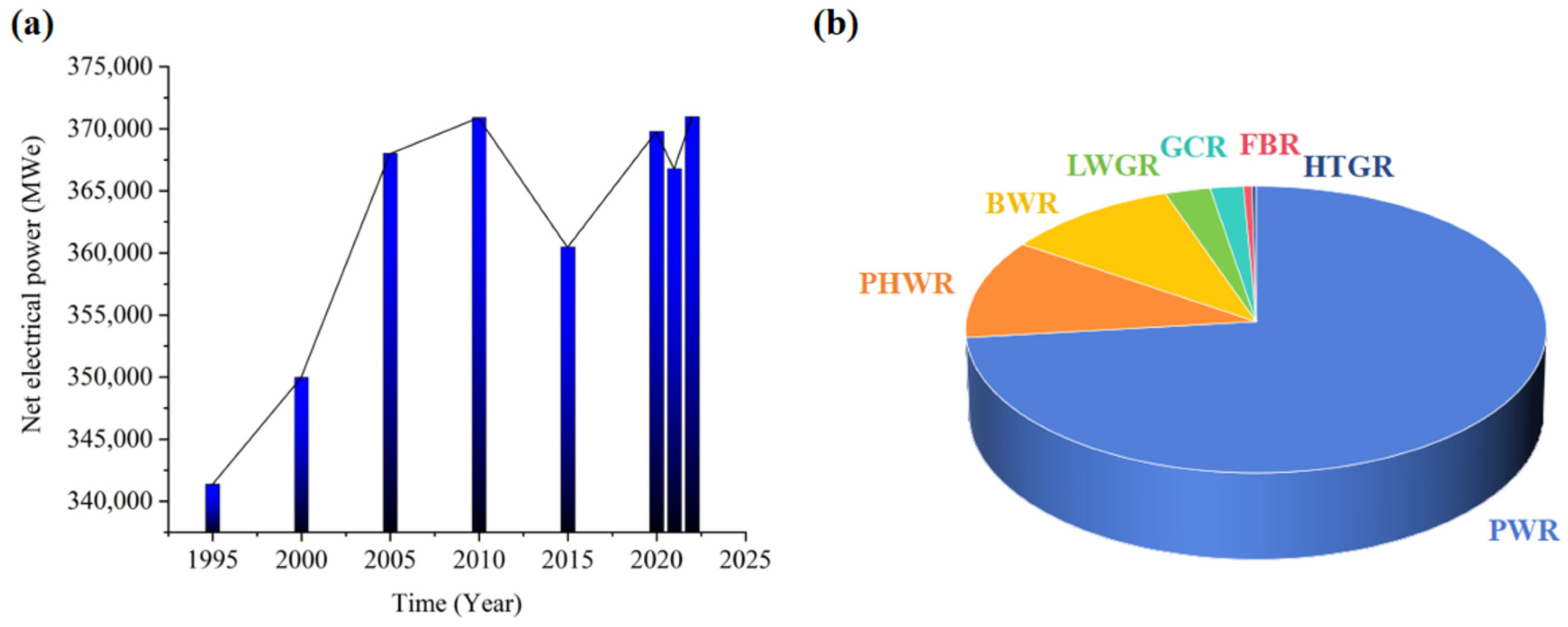
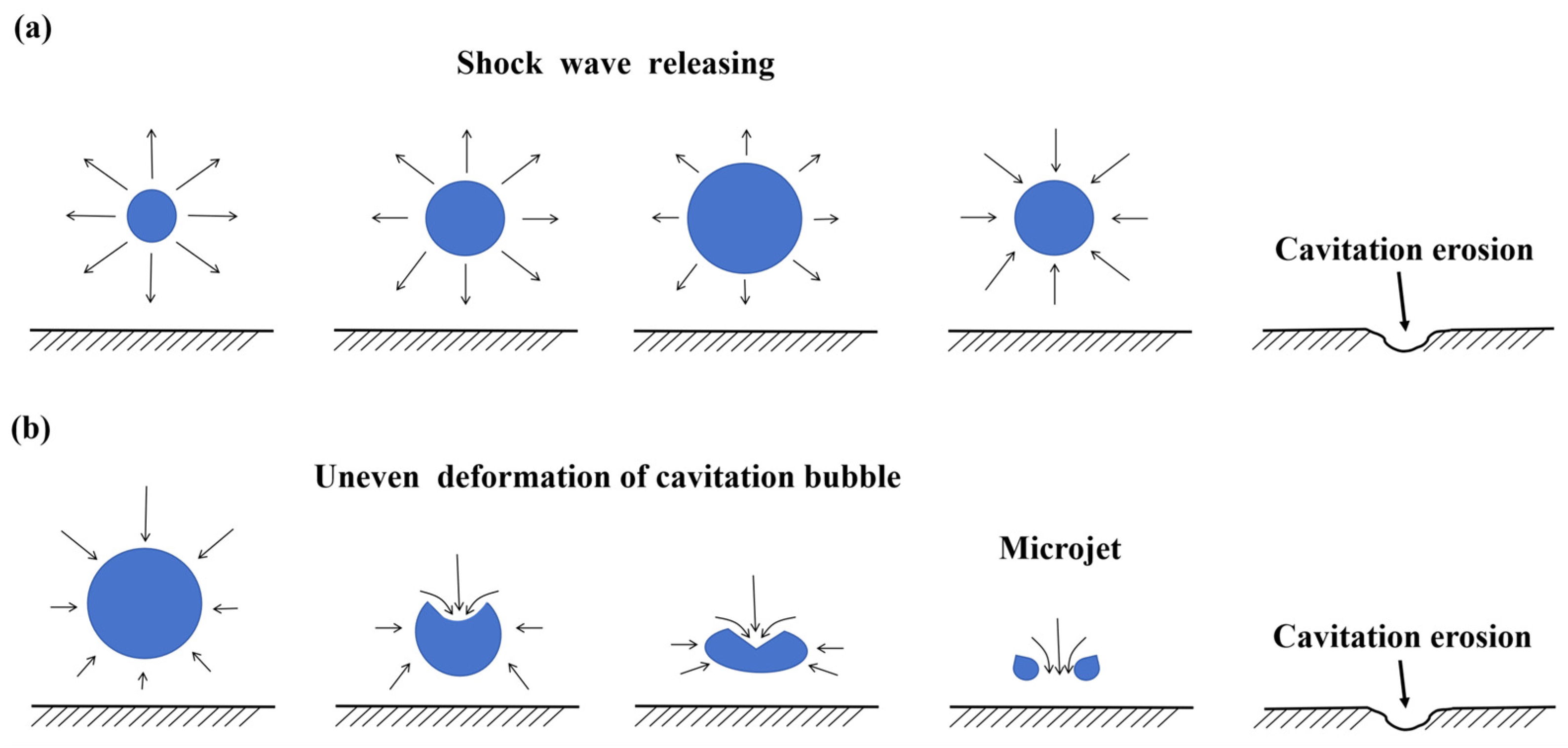
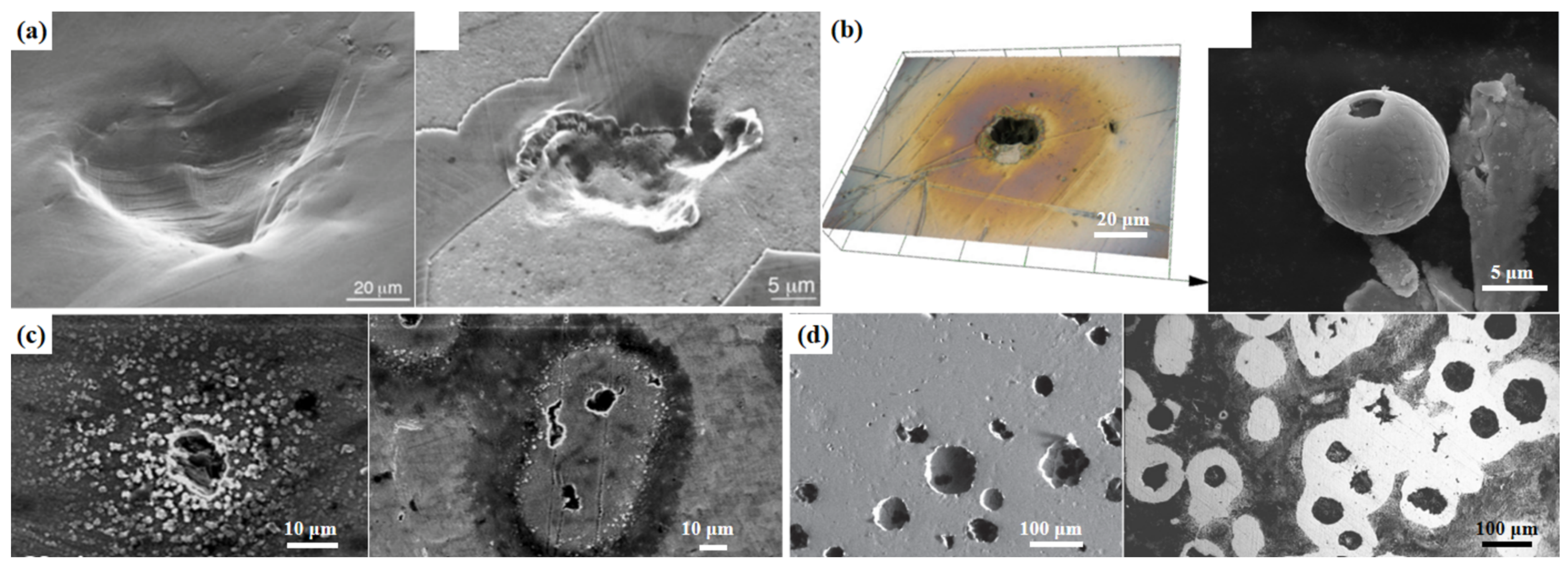



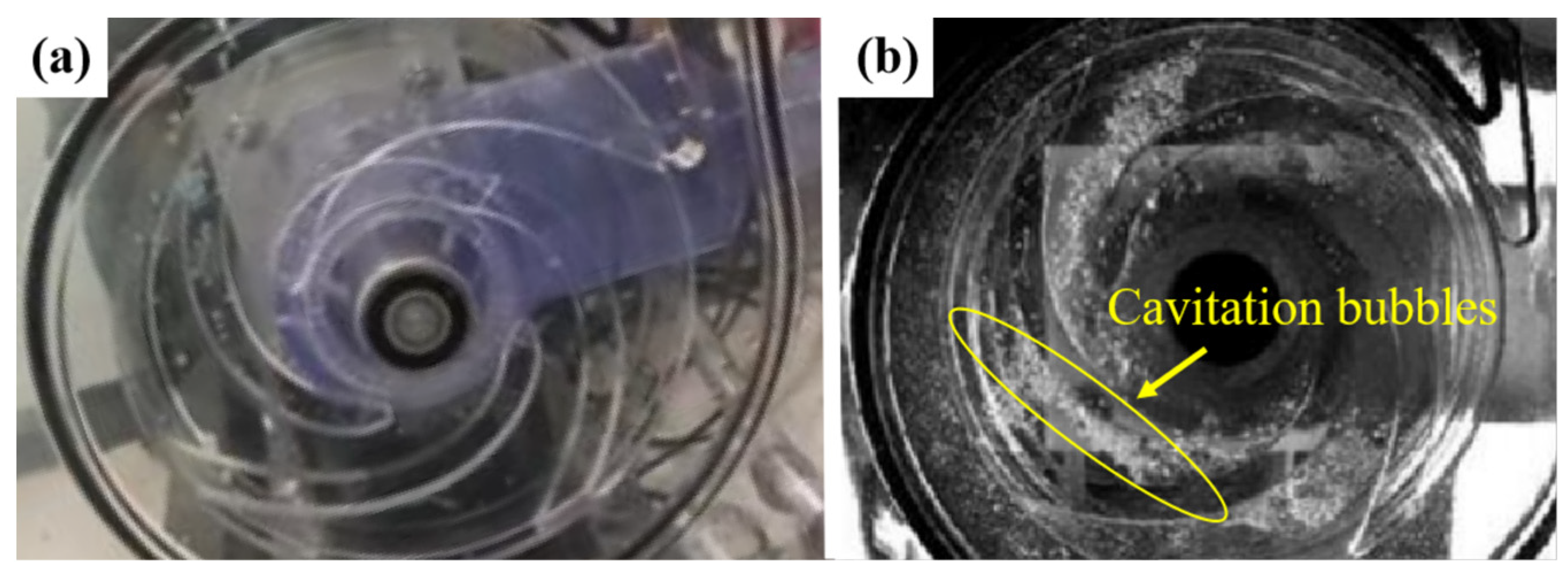
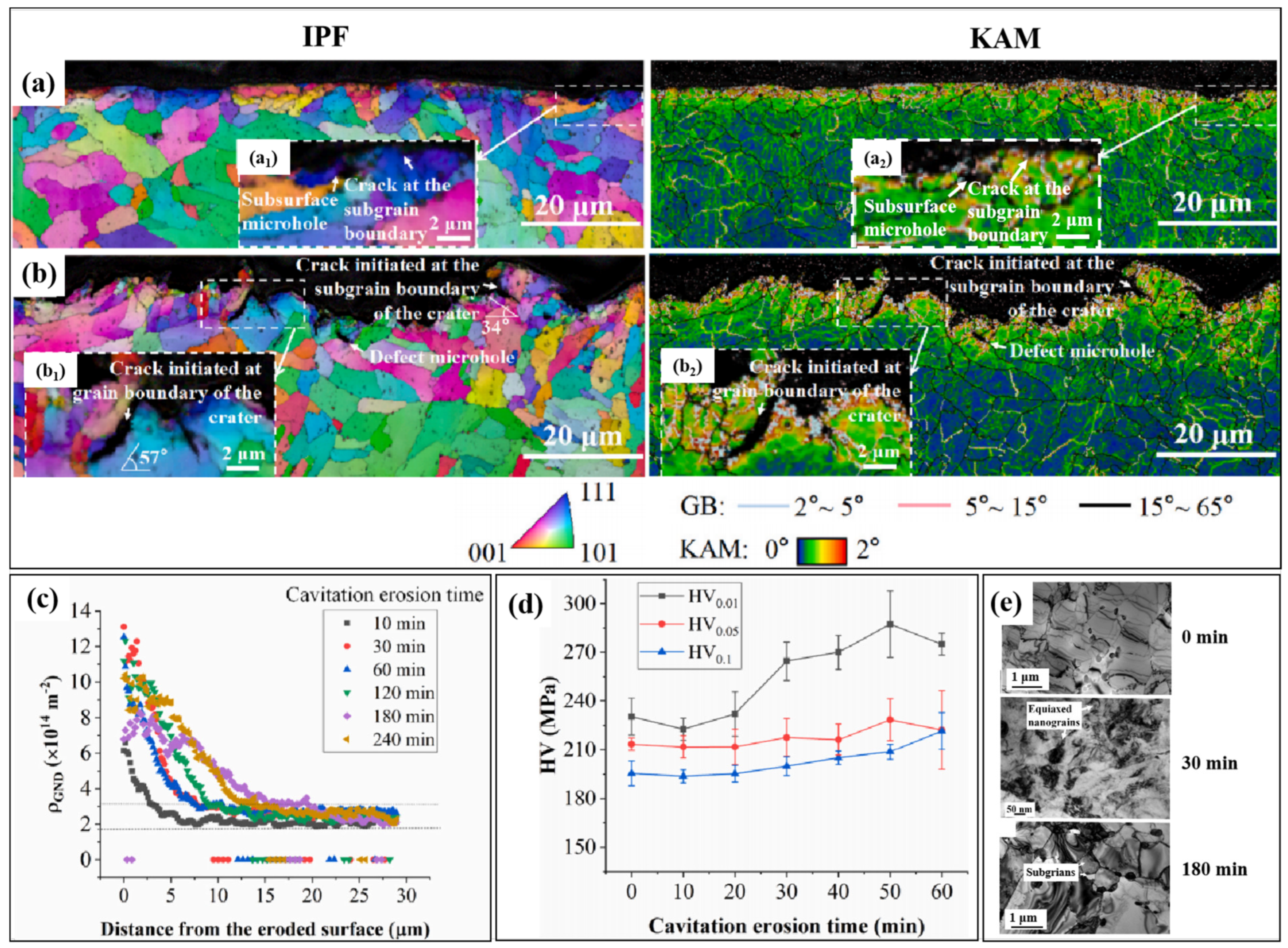
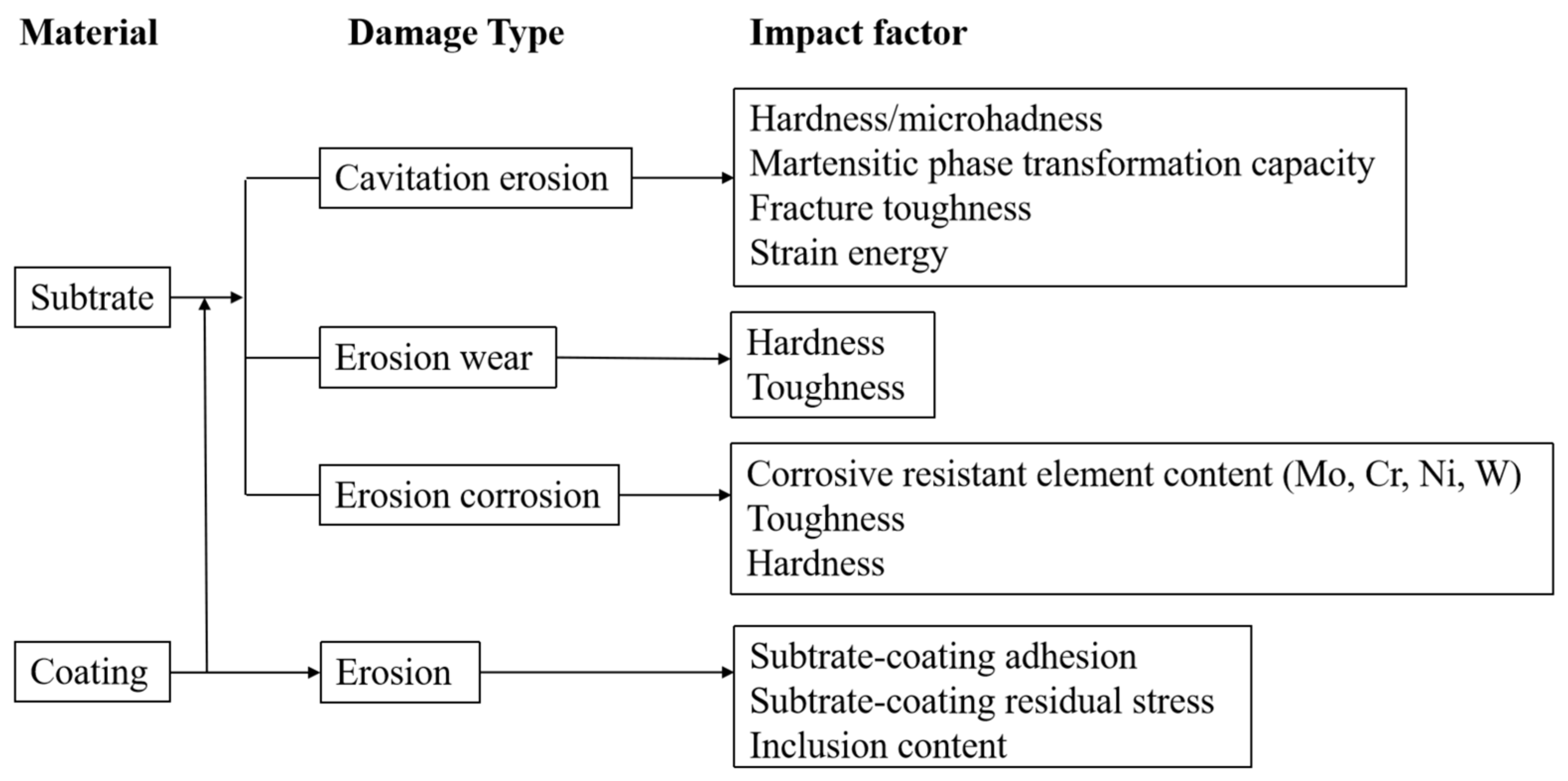
| Material | Microstructure | Hardness | Mean Erosion Depth (μm) | Mass Loss (mg) | Reference |
|---|---|---|---|---|---|
| AISI 420 | Ferrite and carbides | 210 HV0.2 | 300 | - | [71] |
| AISI 420 | Martensite | 270 HV0.2 | 180 | - | [71] |
| C45 steel | Ferrite and lamellar pearlite | - | 23 | - | [23] |
| EN-GJS-400-15 | Ferrite and nodular pearlite | - | 15 | - | [23] |
| SS304 | Austenite | 94 | 0.21 | - | [72] |
| SS316L | Austenite | 84 | 0.25 | - | [72] |
| Tool steel W1 | Martensite | 81 | 0.45 | - | [72] |
| Grey cast iron | Graphite in pearlite | 79 | 1.1 | - | [72] |
| Steel 1.4301 | Austenite | 270 HV | - | 3.5 | [73] |
| Steel 1.4462 | Austenite and ferrite | 319 HV | - | 3.1 | [73] |
| 0Cr13Ni5Mo | Martensite | 298 HB | - | 85 | [74] |
| Cr–Mn–N stainless steel | Austenite–ferrite | 240 HB | - | 52 | [74] |
| Cr–Mn–N stainless steel | Austenite | 211 HB | - | 10 | [74] |
| A-NiCrSiB | Ni-based matrix with hard particles | 908 HV0.05 | - | 10 | [75] |
| C-NiCrSiB | Ni-based matrix with hard particles | 399 HV0.05 | - | 8 | [75] |
| EN-GJL-200 | Ferrite, pearlite, and graphite | 197 HV30 | - | 156 | [75] |
| X5CrNi18-10 | Austenite | 209 HV30 | - | 15 | [75] |
| Alloy | Chemical Element Composition | Ref. | ||||||||||
|---|---|---|---|---|---|---|---|---|---|---|---|---|
| Fe | Cr | C | Si | Co | Ni | B | Mo | W | Mn | Al | ||
| Stellite 21 | ≤2 | 27 | 0.25 | - | Bal. | 2.5 | - | - | - | - | - | [80] |
| Stellite 3 | 0.97 | 30.5 | 2.4 | 0.69 | Bal. | 1.88 | 1 | - | 12.5 | 0.54 | - | [85] |
| Stellite 6 | 2.09 | 29 | 1.25 | 0.81 | Bal. | 2.21 | - | - | - | - | - | [80] |
| Stellite 706 | 1.5 | 28.6 | 1.3 | - | Bal. | 1.6 | - | 6.1 | 0.1 | - | - | [91] |
| Stellite 6B | 2.8 | 28.8 | 1.2 | 1.3 | Bal. | 2.1 | - | 1.5 | 4.5 | 1 | - | [94] |
| FeCr-1 | Bal. | 21 | 1 | 2 | - | 3 | 2 | 2 | 1 | 3 | - | [104] |
| Fe-based alloy | Bal. | 20.11 | 1.69 | 0.99 | - | - | - | - | - | - | - | [80] |
| Norem02 | Bal. | 24.48 | 1.36 | 3.32 | - | 3.88 | - | 2.02 | - | 4.47 | - | [102] |
| FeCrCSiB | 76.7–77.3 | 19.8–20 | 1.7 | 1.0 | - | - | 0–0.6 | - | - | - | - | [99] |
| Ni-3 | - | 24.0–28.0 | 1.0–1.2 | 2.4–2.8 | - | Bal. | 0.8–1.0 | 4.0–6.0 | 4.0–5.0 | - | 6.0–10.0 | [102] |
| Coating | Substrate | Coating Process | Damage Resistance Type | Refs. |
|---|---|---|---|---|
| CoMoCrSi | C22E | Atmospheric plasma spraying | Cavitation erosion | [95] |
| Stellite 706 | Stainless steel | Investment casting or hot isostatic pressing | Erosion–corrosion | [91] |
| CrCW | Stellite 3/6 | Centrifugal casting | Erosion–wear | [93] |
| Stellite 6 | 100Cr6 | Oxygen fuel spraying | Erosion–wear | [94] |
| FeCrCSi | AISI 304 | Cast ingot | Cavitation erosion | [80] |
| FeNiCrBSiNbW | 1Cr18Ni9Ti | Arc spraying | Cavitation erosion | [78,101] |
| Ni-based alloy | 1Cr18Ni9Ti | Laser cladding | Erosion–corrosion | [102] |
| Hidroloy 914/AISI 309 | Carbon steel | Welding | Cavitation erosion | [67] |
| Ceramic composite | MAS/6001 25/5 | Brushing | Erosion–wear | [134] |
| YSZ/NiCrBSi composite | AISI 304 | Atmospheric plasma spraying | Cavitation erosion | [139] |
| Silicon carbide and polymer | Stainless steel | Brushing | Cavitation erosion | [137] |
| Superhydrophobic surface | 12X18H10T stainless steel | Nanosecond IR laser treatment | Erosion–wear | [144] |
| NiAl–Ni3Al intermetallic composites | AISI 420 | Laser cladding | Cavitation erosion | [71] |
| Nanosized TiC ceramic particles | SA 106 Grade B | Liquid metal casting | Cavitation erosion | [59] |
| WC10Co4Cr | 1Cr18Ni9Ti | Oxygen fuel spraying | Erosion–corrosion | [138] |
Disclaimer/Publisher’s Note: The statements, opinions and data contained in all publications are solely those of the individual author(s) and contributor(s) and not of MDPI and/or the editor(s). MDPI and/or the editor(s) disclaim responsibility for any injury to people or property resulting from any ideas, methods, instructions or products referred to in the content. |
© 2024 by the authors. Licensee MDPI, Basel, Switzerland. This article is an open access article distributed under the terms and conditions of the Creative Commons Attribution (CC BY) license (https://creativecommons.org/licenses/by/4.0/).
Share and Cite
Gao, G.; Guo, S.; Li, D. A Review of Cavitation Erosion on Pumps and Valves in Nuclear Power Plants. Materials 2024, 17, 1007. https://doi.org/10.3390/ma17051007
Gao G, Guo S, Li D. A Review of Cavitation Erosion on Pumps and Valves in Nuclear Power Plants. Materials. 2024; 17(5):1007. https://doi.org/10.3390/ma17051007
Chicago/Turabian StyleGao, Guiyan, Shusheng Guo, and Derui Li. 2024. "A Review of Cavitation Erosion on Pumps and Valves in Nuclear Power Plants" Materials 17, no. 5: 1007. https://doi.org/10.3390/ma17051007





